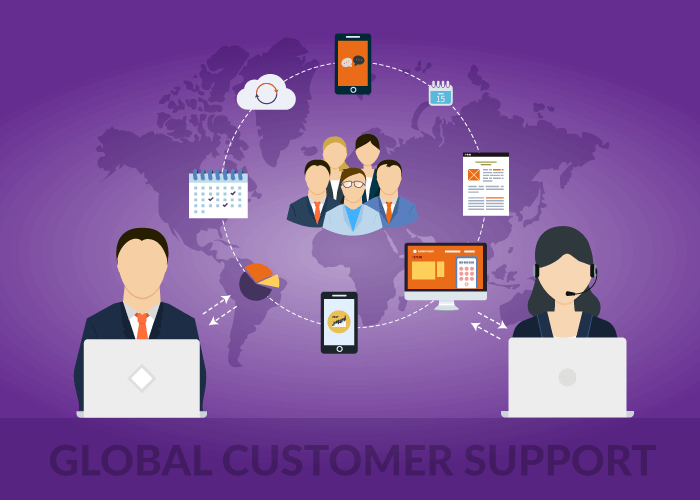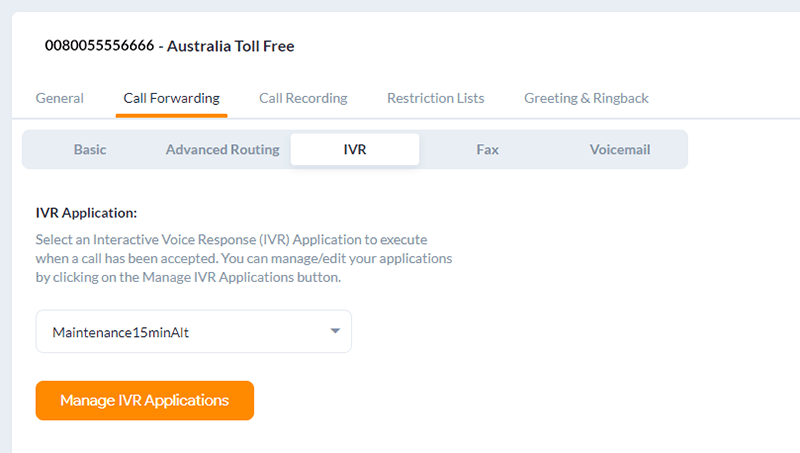With any business move, you want to plan and prepare effectively so that you can make the right decision. Similarly, before you set out to offer 24/7 global customer support, you need to consider a few factors from deciding your customer support infrastructure to finding a global telephony provider.
Here is a detailed guide for businesses preparing to expand internationally and offer global customer support.
Gearing Up to Offer 24/7 Global Customer Support
In this guide to offering global customer support, we will cover the basics of providing global customer support:
- Does Your Business Need to Offer Global Customer Support?
- Benefits of 24/7 Customer Service
- How Can Your Business Offer 24/7 Support?
- 9 Things You Need to Do Before Providing Global Customer Support
Does Your Business Need to Offer Global Customer Support?
The short answer is — it depends on your company and business goals. Does your company plan to expand internationally? Do you have customers in multiple countries spread across the globe? Do you want to offer more responsive and 24/7 customer support?
Global customer support is a way of offering 24/7 customer service by positioning your support teams globally. This way, you can access a broader customer base, establish a local presence in target markets, and increase international sales.
Benefits of 24/7 Customer Service
So, why should your business consider offering global customer support and technical support?
- Get more global customers
- Expand global reach and coverage
- Add new markets and regions to your business’ customer base
- Meet rising customer expectations
- Balance the workload across multiple support teams
- Retain more customers by offering responsive support
- Increase revenue and sales
How Can Your Business Offer 24/7 Support?
There are a few different ways your business can offer global 24/7 customer support:
- Phone support — Routing inbound calls to customer support agents wherever they are located.
- Email and ticketing software — One of the most popular 24/7 support options to help customers report an issue and receive automated responses till a customer support agent is available for assistance.
- Live chat and chatbots — Offer troubleshooting support via chat, answer simple requests, and collect customer data.
- Self-service support — Offer Knowledge Base and support articles, FAQs, and tutorials that answer common questions and resolve issues without live interaction.
- Automated support — Includes AI chatbots, interactive voice response (IVR systems), email automation, and so on.
However, what you offer depends on your resources and budget. You may find phone service providers or customer service solutions that offer a bundle of these services together for discounted rates. Consider your options before making a decision.

9 Things You Need to Do Before Providing Global Customer Support
There are a couple of things you need to watch for before you set out to offer 24/7 global customer support — from finding new technology to using automation to streamline business processes.
Here are 9 factors to consider if you want to offer 24/7 global support:
1. Decide How Your Business Will Offer Global Global Support
The first thing you need to consider while preparing your business for global support is to decide how you will offer service and assistance internationally. Depending on your resources and budget, you can find a global customer support solution that allows you to reach a wider audience and increase international sales.
The most common setup for international customer support is offering global voice support accompanied by email, live chat, and self-service support. But you can configure your setup to meet your business needs and goals. Here are some ways you can offer support:
- Phone calls with in-house customer service agents with advanced routing
- Outsourcing customer support calls to call centers and contact centers
- Live chat and chatbots
- Email support and ticketing
- Video support and conferencing
- Social media management
- Self-service support
2. Choosing a Global Telephony Provider
Next, you need to find a global telephony provider who can support voice and business communication requirements. Determine the different factors your business needs to offer global customer support efficiently. Then, look for a provider with solutions that help your employees accomplish these goals. Some features and services to look for in a global telephony provider include:
- Voice coverage in target countries and regions.
- Cloud phone numbers such as local and toll free numbers from countries worldwide.
- Advanced call routing and international call forwarding.
- Cloud IVR or auto-attendants.
- Support for other communication channels such as email, voicemail, text messaging, fax, etc.
- API to integrate into your existing system.
- Softphones to let users make and receive calls from any location or device.
- 24/7 technical and customer support.
These aside, you can get access to other premium services and tools. Review what different providers have to offer so you can find the right fit for your business.
3. Choosing Between On-Premise Support vs. Call Center Outsourcing
At this point, you will also need to decide whether you want to run this on-premise with cloud call center technology or outsource to an omnichannel call center.
On-Premise Cloud Call Center Software
Cloud call center software comes equipped with various features and tools that help you offer global customer support from your headquarters, satellite offices, and remote agents. Your business can adopt a follow the sun support model by routing calls to employees in different regions.
In other words, with cloud-based software, you can hire employees in multiple locations and connect them to your centralized hub. You do not need additional services for these employees. Simply route calls to different locations during different hours. This gives you more flexibility and control over your customer support.
Additionally, since most providers offer different pricing options, you can choose one that works well within your budget. This way, you can cut down on outsourcing calls by managing everything with in-house and remote teams.
Call Center Outsourcing
Call center offshoring companies specialize in customer support and have access to the technology to offer quality service. So, if you don’t want the hassle of running your own call center, you can outsource to centers offering global and multichannel support. This can prove beneficial to your business if you do not have the infrastructure to support global teams.
Related: Top 16 BPO Call Centers in the United States
4. Plan for the Costs of Running a 24/7 Support Service
Next, you need to pay attention to the costs of running a 24/7 global support service. This varies based on a few different factors:
- The areas and regions you want to cover
- On-premise cloud call center software:
-
- Number of users (in-house and remote)
- Call center software costs + additional premium services ($15-$100 per month)
- Any equipment, if needed, such as desk phones, headsets, etc.
- Staffing and training costs ($15-$25 per hr)
-
- Call center outsourcing costs ($25-100 per hour per agent)
- Additional services such as creating a knowledge base and online support center for customers and agents.
Shop around to see where you might be able to cut down costs. For example, you can have your company’s in-house content team work on the knowledge base and support center. Or, you can use a provider that offers multiple services and equipment under one discounted price and that covers a large global network. Speak with different providers to understand what options you have available to accommodate your business needs and decide accordingly.
5. Position Teams in New Markets
Once you have the plan and technology to support your global customer service, you can start placing teams in new regions and markets. You can do this cost-effectively by opening up small satellite offices or hiring remote agents. Then, you can integrate these users into your centralized hub.
It is important to create a process for how exactly your business will offer global customer support. Think about:
- What call routing strategies you will use and how calls will be routed,
- What other communication channels will these teams have access to,
- How will agents report to their managers,
- What skills and experience do you need your agents to have,
- What customer relationship management (CRM) software will you use to record customer interactions and information, and so on.
6. Set Up Call Forwarding and Advanced Routing
Next, set up call routing and forwarding rules. Cloud-based phone service providers will offer advanced call routing that allows your business to route calls based on different predetermined and custom rules. You can set and adjust these rules to match your customer support infrastructure. Here are some common call routing strategies:
- Time-based routing — Routes calls to specific locations or lines based on the time the call comes in.
- Geographic call routing or georouting — Routes calls to specific locations or numbers based on the caller’s location.
- Skill-based routing — Forwards calls to the right department or agent based on certain skills such as language or departmental knowledge.
- Simultaneous ringing — Enables multiple phones to ring at the same time when a call comes in.
- Sequential forwarding — Routes calls down a predetermined list of users.
7. Hire Employees with the Necessary Skills
Hire the right employees to represent your company. This means paying attention to different cultures, customs, and languages for the regions you offer services. You want to find agents who can speak multiple languages, are culturally sensitive, and practice international phone etiquette. Whether you hire locally or outsource to a BPO, you want to ensure they represent your company and brand appropriately. Conducting training sessions and refreshing company values and missions is a good way to ensure everyone is on the same page.
Related: How to Create a CX Strategy for Global Customer Support
8. Build a Self-Service Support Center Accessible Online
Next, you should also prepare a knowledge base or support center online to make it easy for customers and agents to get help and support. This can be filled with FAQs, how-to guides, tutorials and webinars, articles, troubleshooting help, and more.
It is a good idea to have one that your customers can access through your website and another available internally for your agents. This way, customers can get help for quick and straightforward problems while agents have access to support information for more complex issues.
9. Create Efficient Processes with Automation
Lastly, you may want to consider using automation and AI tools to automate your processes and make your teams more efficient. You could use an interactive voice response system (IVR) or auto-attendant to route calls based on your predetermined rules automatically. You could also set automated responses to trigger when customers send emails, submit query forms, submit a ticket, and so on. Another common use of AI is to have a chatbot assist web visitors in getting answers, submitting tickets, etc.
How Can Global Call Forwarding Help?
Global Call Forwarding is a global telephony provider that offers various cloud communication solutions — from international phone numbers to advanced call routing. You can customize your business communication system to create one that is compatible with your global customer service. Call us to learn more about our services or chat with us online! We can help you reach your customers no matter where they are!






















